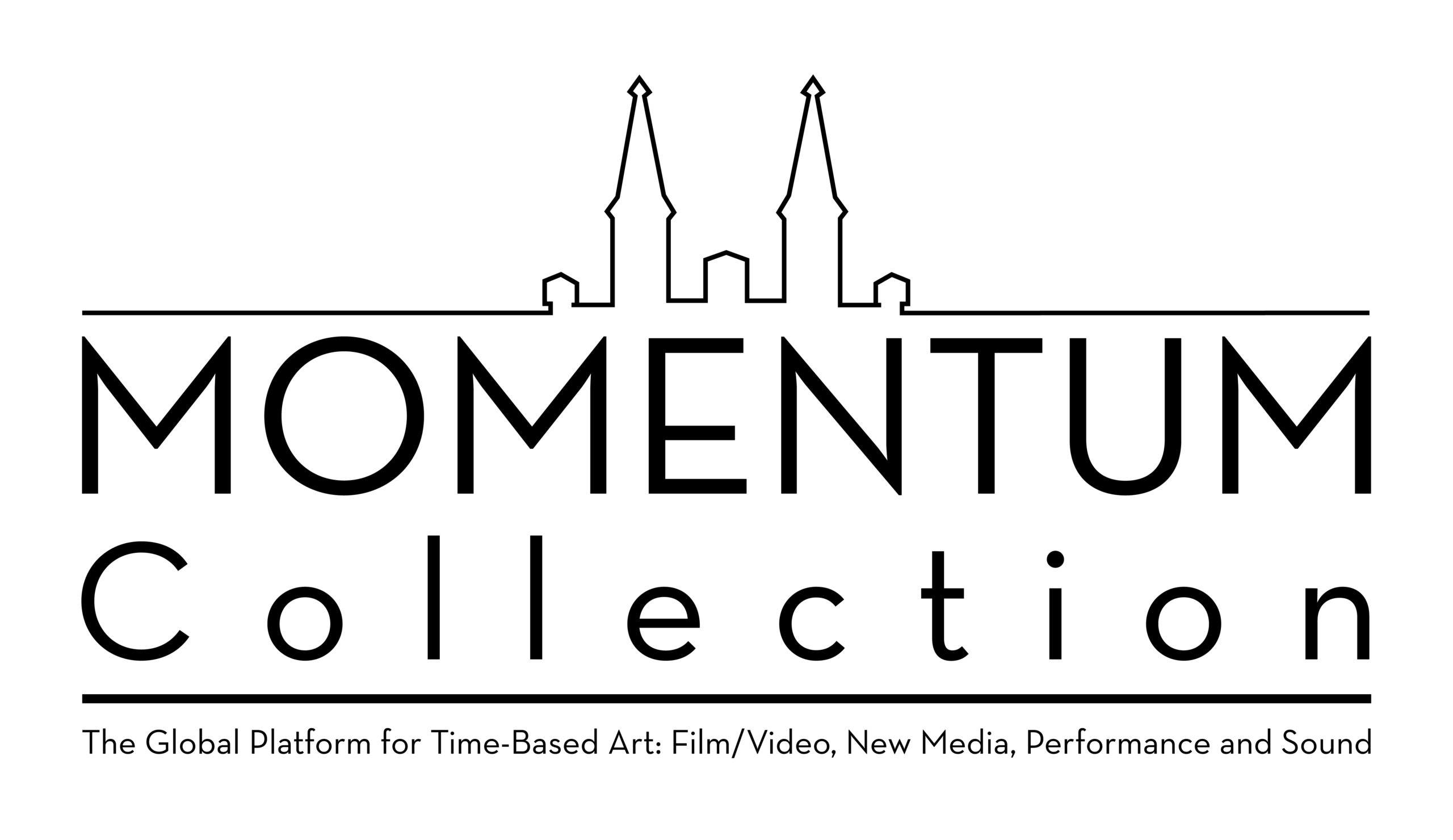ART from ELSEWHERE:
Danube Dialogues
Selected Artists from the MOMENTUM Collection
19 August – 15 September 2022
Presented at the
Danube Dialogues Contemporary Art Festival
In the historic Karlovci Gymnasium, Sremski Karlovci, Serbia
for the European Capital of Culture 2022 Novi Sad
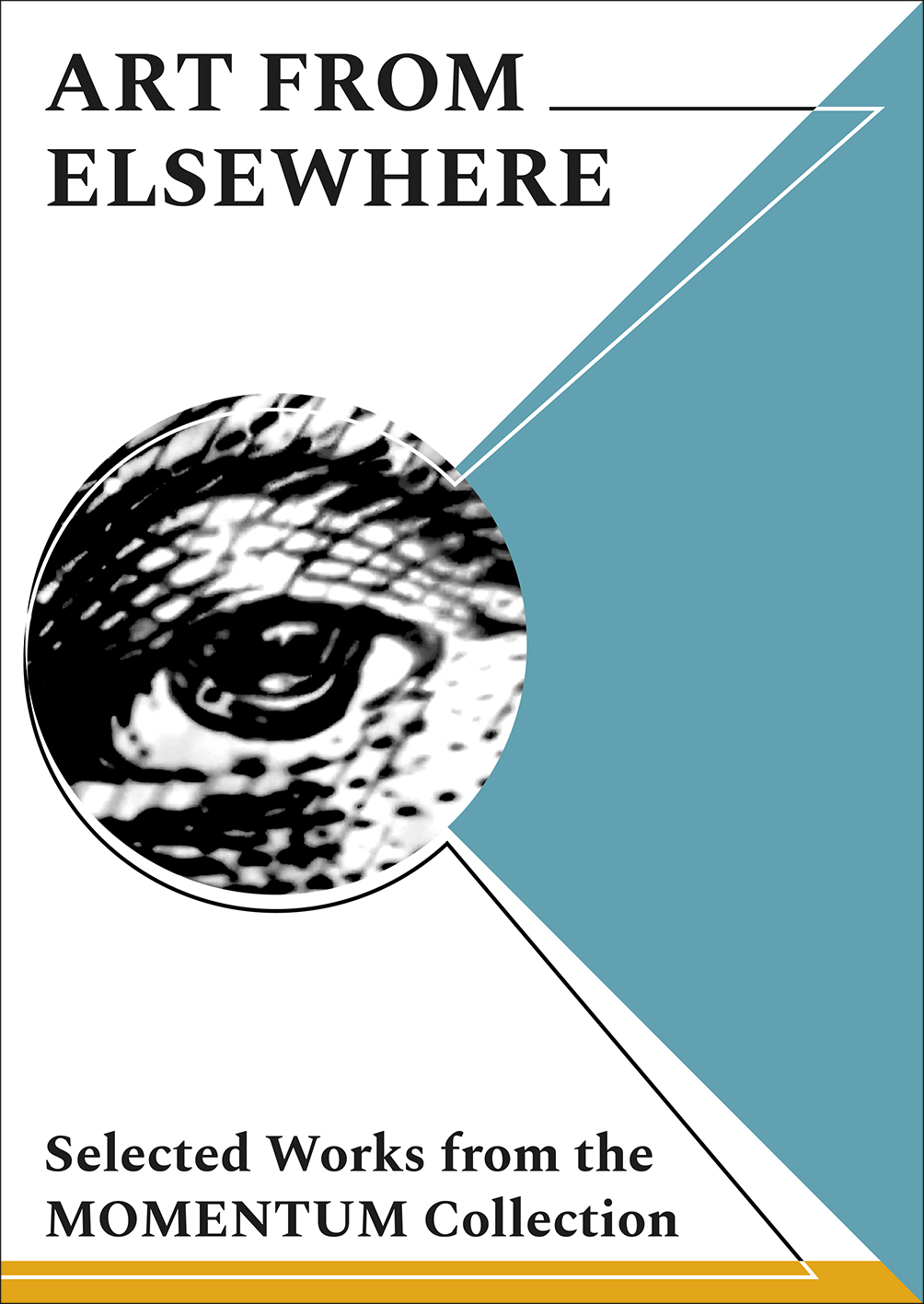
Featuring:
Marina Belikova // Claudia Chaseling // Nezaket Ekici // David Krippendorff // David Szauder // Mariana Vassileva // Vadim Zakharov
Curated by Rachel Rits-Volloch
Presented in Parallel to:
Danube Dialogues – Off-Centre
Inna Artemova // Claudia Chaseling // Milovan Destil Marković
ART from ELSEWHERE: Danube Dialogues presents a selection of video artworks by seven artists from the MOMENTUM Collection, Berlin, who come from the Danube regions of Germany, Hungary, and Bulgaria. MOMENTUM’s program is presented for the European Capital of Culture 2022 Novi Sad, in the Danube Dialogues Festival in Sremski Karlovci, Serbia, and is shown in parallel to the exhibition “Danube Dialogues – Off-Centre”, featuring Milovan Destil Marković, Claudia Chaseling, and Inna Artemova – three of the artists from the MOMENTUM Collection.
ART from ELSEWHERE is a series of travelling exhibitions, taking a new site-specific form in each edition and location, showcasing works and artists from the MOMENTUM Collection, Berlin.
Today most of us live lives of perpetual motion from one piece of information to the next, from one opportunity to the next, and – until COVID-19 stopped us in our tracks – from one place to the next. Mobility – both geographical and social – not so long ago the privilege of the few, is now taken for granted as the entitlement of the majority. Artists are at the forefront of this peripatetic existence, travelling the world for inspiration, exhibitions, and artist residencies, experiencing new places and cultures through the critical lens of the outsider, and then reflecting back upon their own locales through the prism of their expanded world views.
ART from ELSEWHERE: Danube Dialogues is a program of video artworks by artists based in Berlin, and as diverse as Berlin itself. Presenting artists from Bulgaria, Germany, Hungary, Russia, and Turkey – they are all also Berliners. At the geographical center of Europe, Berlin is a city of mobile people and moving images, where art and artists alike are predominantly from elsewhere. “ART from ELSEWHERE: Danube Dialogues” is a video program about otherness; about communication and its opposite; about the ways in which we see the world and interact with it. Moving images move us, and artworks serve as windows onto the world. As we emerge after periods of isolation, and learn how to negotiate the new realities of a post-pandemic world, it becomes more important than ever to have such windows through which to gaze. In these uncertain times, they remind us that, for all our differences, we are all in this together. The works shown in this program focus on global issues, equally relevant to us all, no matter where we live or where we have come from. They reflect on the social and environmental repercussions of globalization and its impact on the transformation of cultural identities; they interrogate issues of identity, inequality, and poverty; they scrutinize the environmental traumas we inflict on our planet and its creatures; and they ponder the (un)quiet poetry, conflicts, and beauty of how we must live from day to day.
Learn more about the MOMENTUM Collection > >
(Click on the artist name to see the bio and the work description below)
Inna Artemova
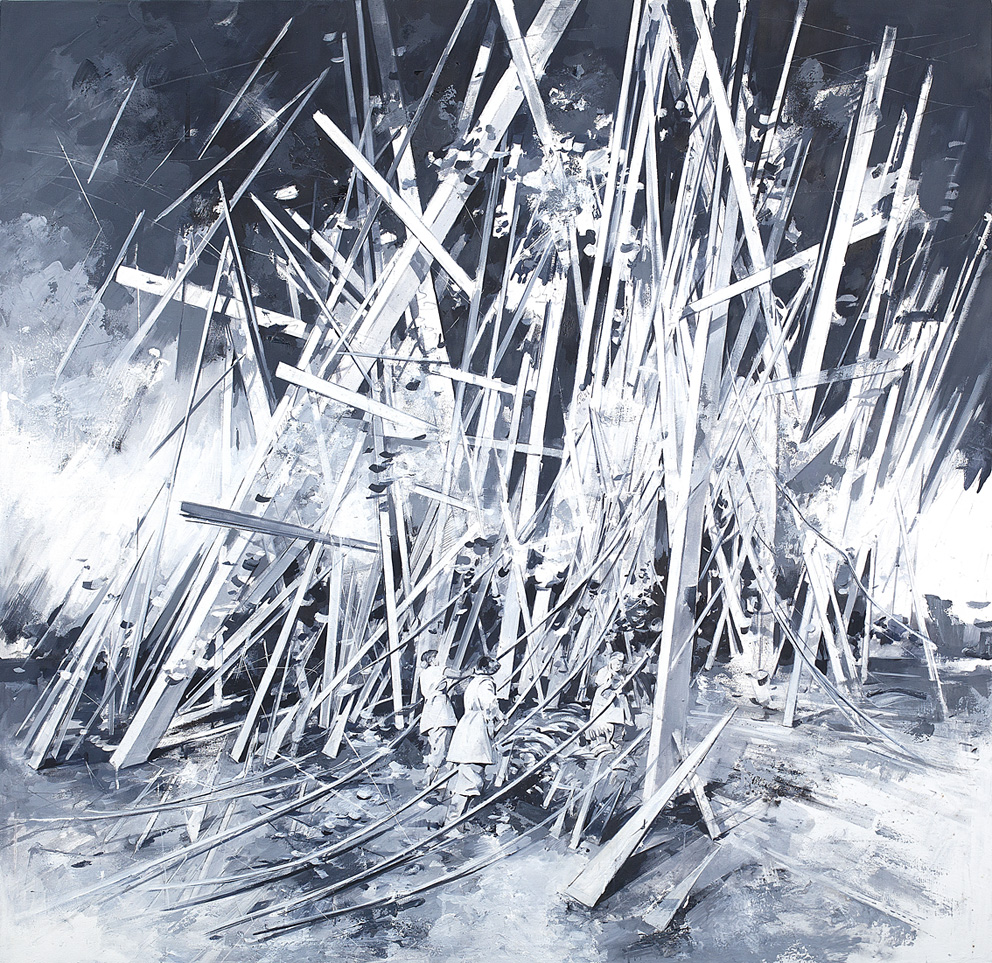
Utopia V (2017), Oil on Canvas, 155 x 160 cm (on loan from the artist)
Artemova’s paintings, as well as her wall installations escaping the boundaries of the 2-dimensional, embody Artemova’s focus on architectures of utopia. Yet while the idea of utopia is the dream of a perfect society, these works evoke a sense of impending cataclysm, as yet quite far removed from an idealized state of perfection. Seeming to capture the aftermath of some volatile force, this exploded and explosive installation sends a suitably ambiguous message about the future and the present. The sense of velocity in Artemova’s works gives her floating structures a futuristic speed, propelling them – as the titles of her Utopia series suggests – into a more perfect future. Contriving to comingle a notion of existential threat with the sense of the sublime, these works can be seen as a portrait of our precarious times. Having witnessed first-hand the collapse of the Communist utopia in her native Soviet Union, Artemova’s utopias are fragile constructivist visions in a state of constant flux; exploding, imploding, teetering on the edge of a perilous balance, or perhaps already being rebuilt. Every collapse presents the hope of a new beginning; a renewed dream of an ideal future. Utopias are too often built on the ashes of their opposites.
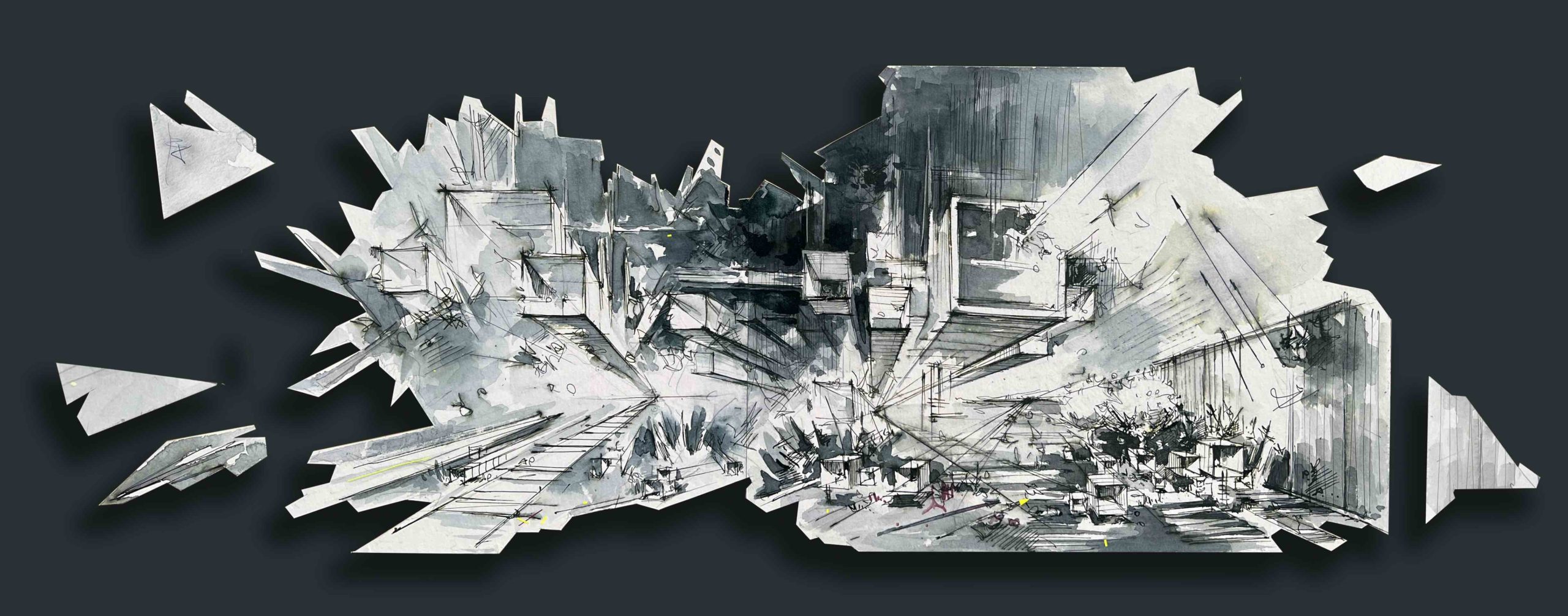
Utopia H 2836 (2021), ink, marker, paper on cardboard, approx. 30 x 84 cm (on loan from the artist)
Inna Artemova (b. Moscow, USSR. Lives and works in Berlin, Germany.)
Born in Moscow, Inna Artemova studied architecture at the Moscow Architectural Institute (MArchI). For her diploma project, she received the 2nd prize of the Russian Federation. In 1998 she moved to Berlin and started to focus on her work as an artist in the field of painting and drawing. Artemova’s practice remains heavily influenced by her professors at the MArchI in Moscow, the “Paper Architects“, a movement originating in the 1980s that developed futuristic architectural creations never intended to be realized. The visionary projects of the Paper Architects and her experience of the failure of the Communist utopia with the fall of the Soviet Union, has led Artemova to explore, through her constructivist painting style, the ideas of architectural utopias from the 1960s up to her own futuristic visions. In creating utopian landscapes and spaces, Artemova interrogates the future of living spaces and their impact upon human relationships. The concept of utopia stands for a space of possibility in human consciousness in which the crucial questions have to be answered again and again: Is there no alternative to the reality in which we live? What will we do in the future? Do we have to fail because of our ideal ideas? Artemova’s work is included in the major survey exhibition and publication “DISSONANCE. Platform Germany” (2022) edited by Mark Gisbourne & Christoph Tannert. Her work has been shown in numerous international exhibitions, biennales, and collections.
Marina Belikova
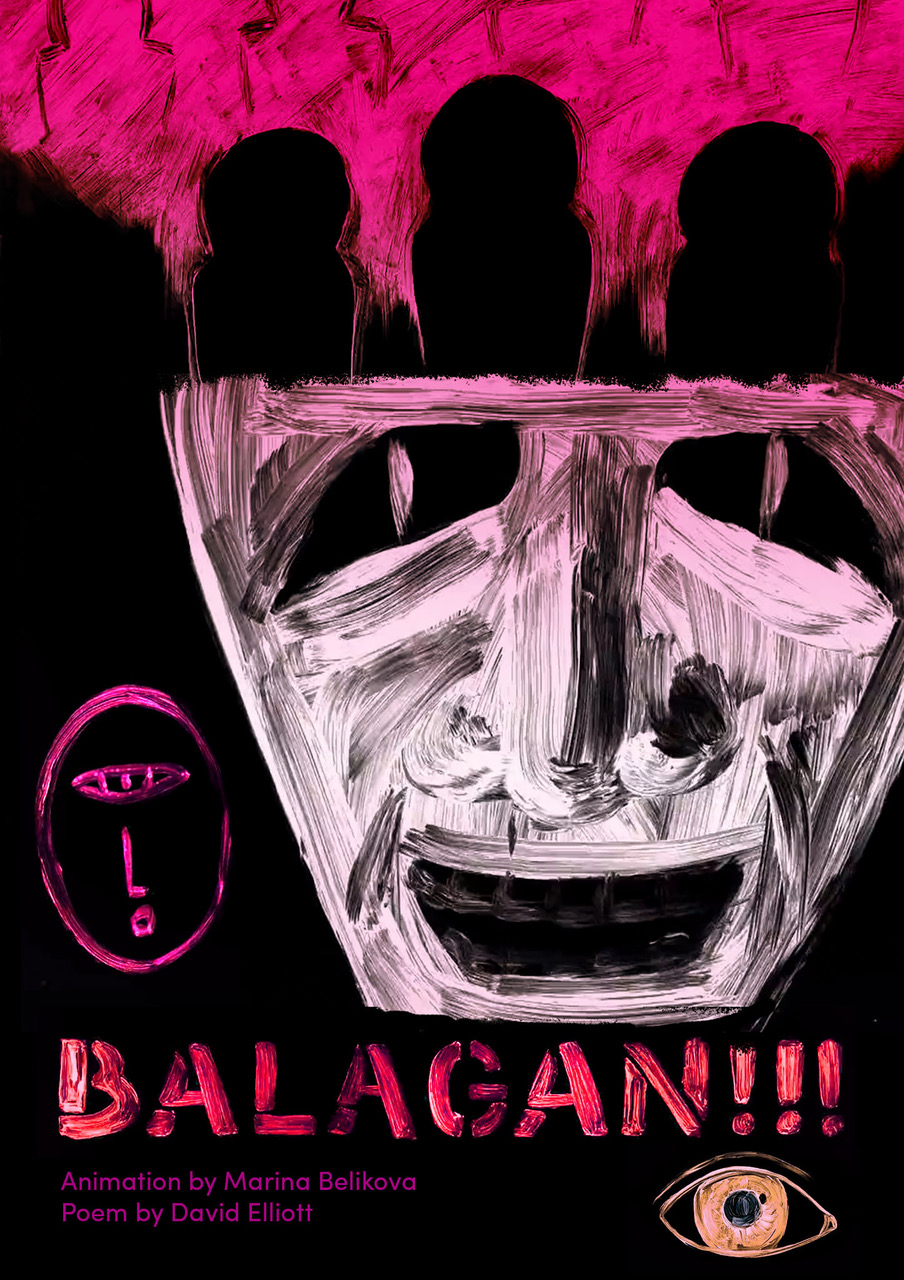
BALAGAN!!! (2015), video animation with sound, 1 min. 47 sec. (courtesy of MOMENTUM Collection)
In Russia balagan is a popular exclamation that describes, with celebratory gusto, a farce, a fine mess, the most unholy of cock-ups. BALAGAN!!! is also a major international exhibition produced by MOMENTUM in 2015 of contemporary art from the former USSR and Eastern Bloc that reveals a world where chaos and misrule, along with the social comedy that results from it, are celebrated and scathingly exposed. Balagan originally meant ‘fairground’. By the 18th century it had become associated with the activities of the people who worked in them: puppeteers, clowns and jesters, who made fun of and satirised established order. And, from the beginning, artists have realised the potential of balagan as an effective framework for revealing the truth. Today, the revolutionary politics of laughter, as well as the cathartic release it promises, are engendered by a sense of outrage at cruelty, inhumanity and the abuse of human rights. But balagan is not only modern: ever since time began, chaos has been ever-present. The exhibition BALAGAN!!! Contemporary Art from the Former Soviet Union and Other Mythical Places is about how some artists choose to depict the chaos of our times critically, challenging its power through humour, parody and the power of art itself. For this exhibition, the curator David Elliott wrote his own unique description of BALAGAN, which Jonathan Barnbrook designed, and Marina Belikova visualized as an animated film. We reprise BALAGAN!!! for Birds & Bicycles, as it remains equally relevant to our world today, still afflicted by chaos and misrule, and now also a global pandemic to contend with. Perhaps the power of humour, parody, and art itself lies in its ability to lift us out of the darkness and, soaring above it, develop new perspectives and better hopes.
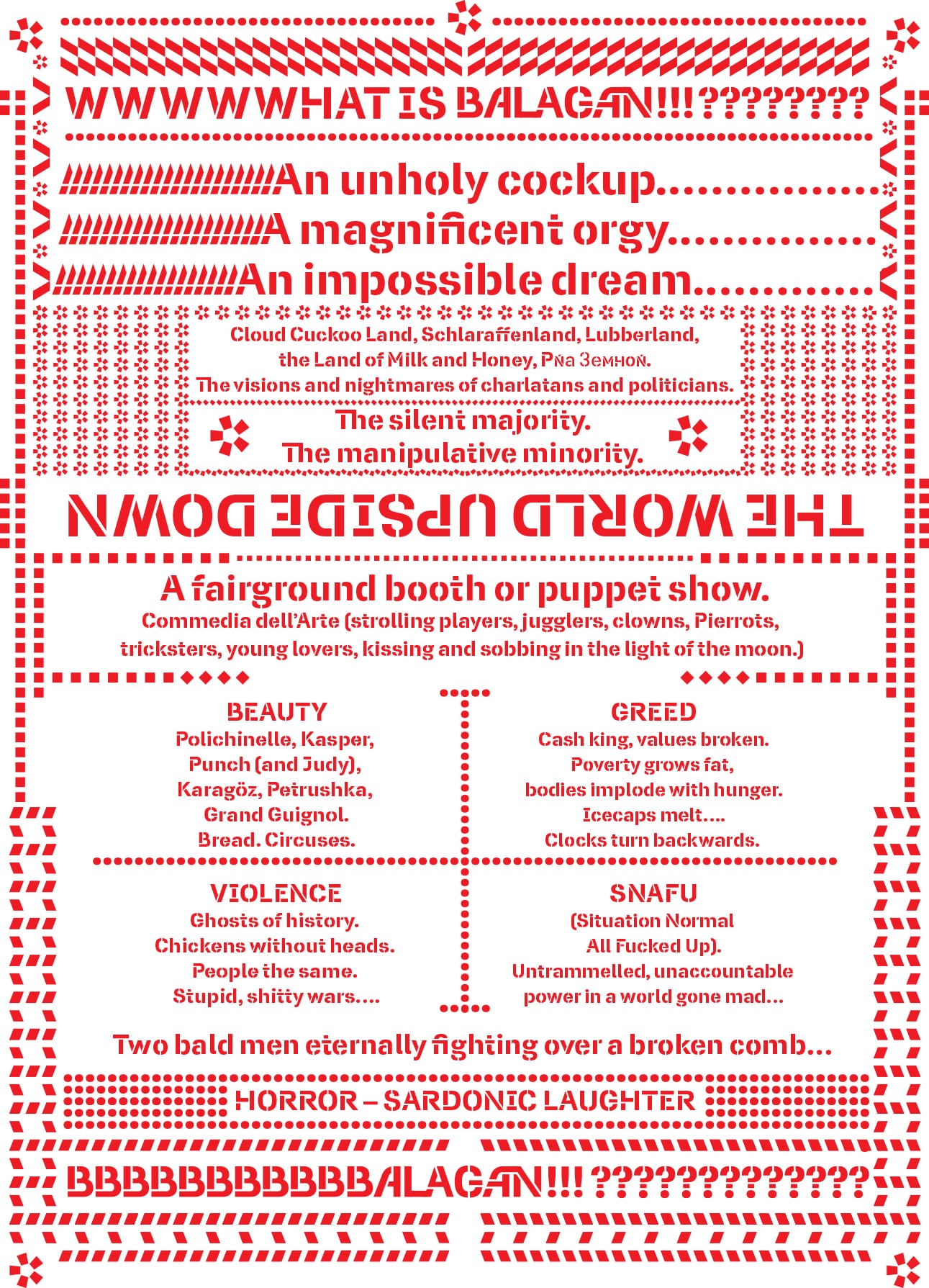
David Elliott (text) & Jonathan Barnbrook (graphics), BALAGAN!!! (2015)
Marina Belikova (b. 1989 in Moscow, Russia. Lives and works in Berlin.)
Marina Belikova is a Berlin based media artist, working with photography, graphic design and 2D animation. She has a background in web and media design. In 2012-2013 she completed an M.A. in Communication Design at Kingston University, London and in 2016 she graduated from the Bauhaus University, Weimar with an M.A. in Media Art and Design, specializing in oil-on-glass animation techniques. Belikova animates her narratives through the traditional technique, where each frame is painted individually and subsequently captured with a camera as stop motion animation. She also works with photography and mixed media, exploring the topics of human memories and interaction between people and urban spaces. Her award-winning animations have been screened at numerous film festivals in more than 10 countries, and her photo series have received the Bauhaus Essentials Prize and have been shown in various international exhibitions.
Claudia Chaseling
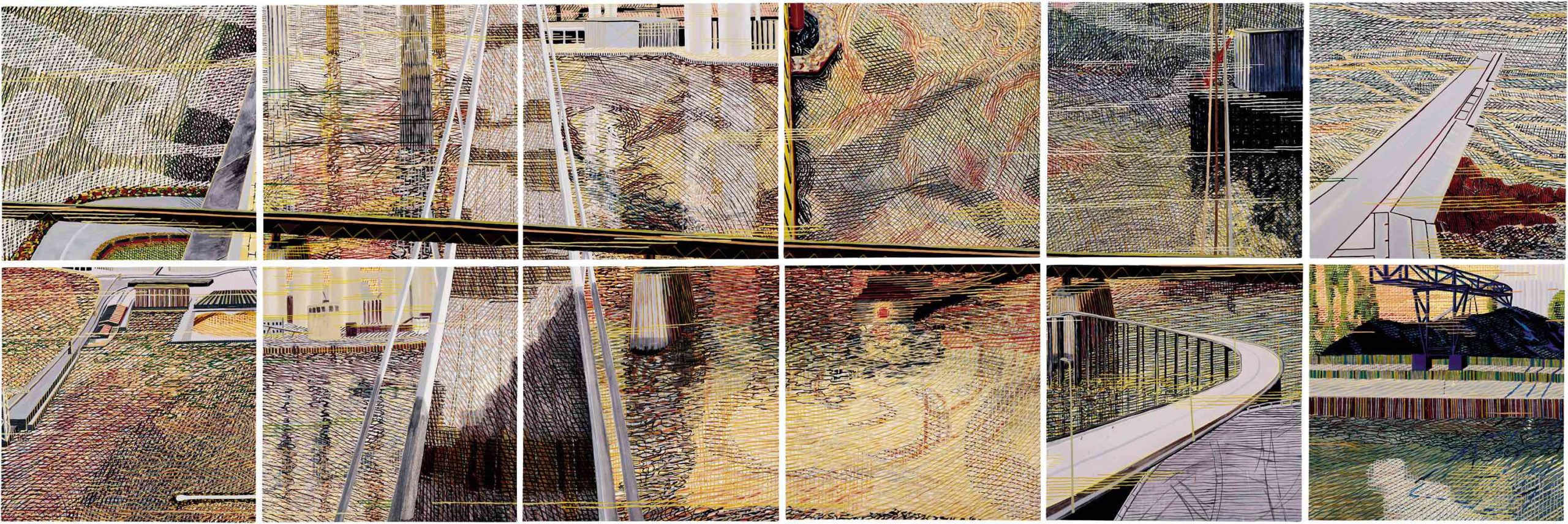
On The Edge (2005), Egg Tempera & Oil on Canvas, 180 x 540 cm, (on loan from the artist)
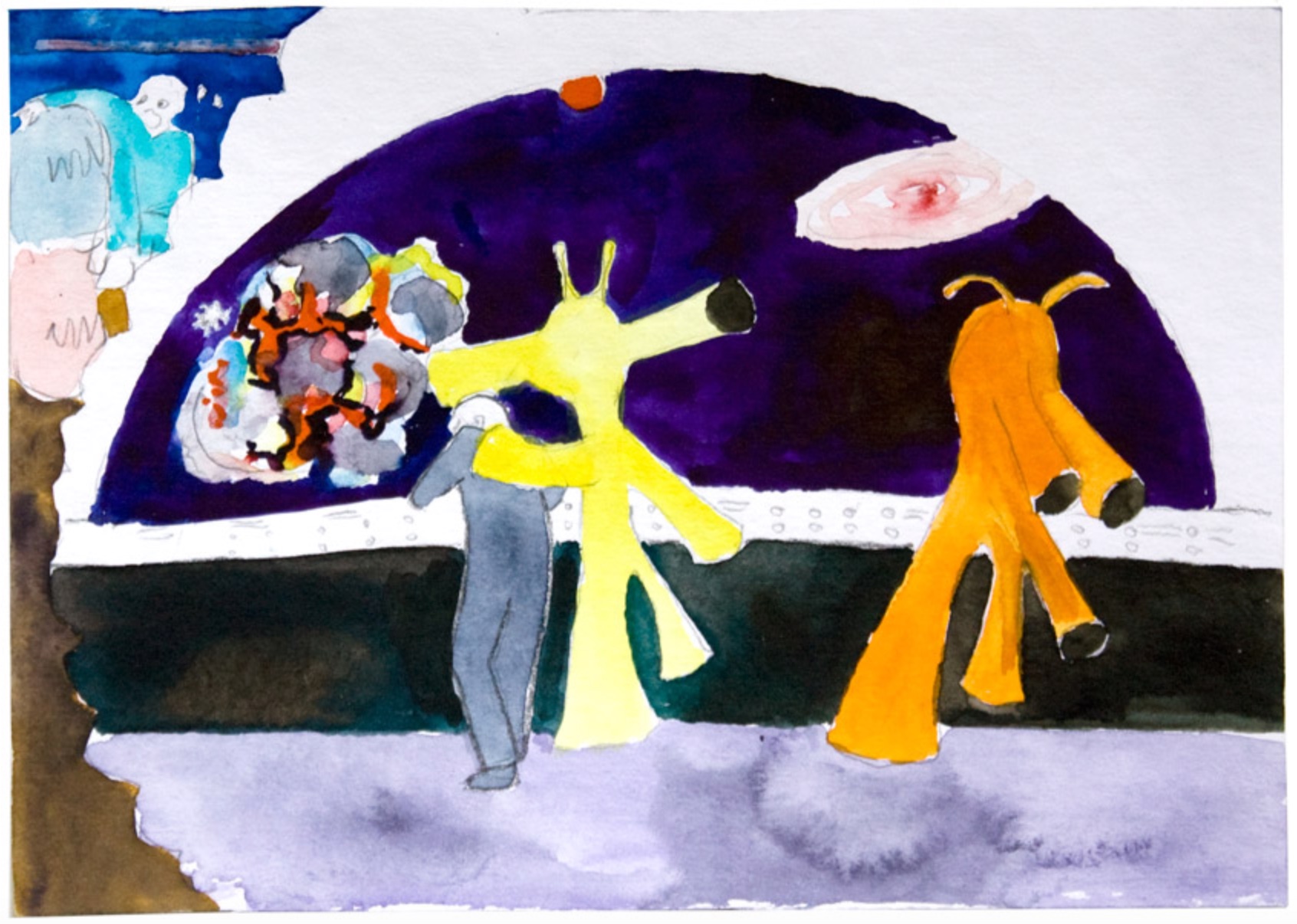
Murphy the Mutant (2013), HD Video with Sound, 14 min. (courtesy of MOMENTUM Collection)
Splashes of bright colors in biomorphic forms. Shapes and hues redolent of crackling, explosive energy. Claudia Chaseling’s work confronts viewers with a psychotropic saturation of visual information interlaced with text and the URLs of source materials for her research. What seems initially to be pure abstraction, is in fact a complex visual analysis of the radioactive contamination caused by depleted uranium munitions.
Murphy the Mutant is Chaseling’s fist graphic novel of watercolors animated through video and read out loud by the artist. This seminal work marks the starting point of Chaseling’s enduring focus upon the nuclear chain leading to depleted uranium and its toxic aftermath, which forms the subject of her body of work over the past decade. By means of it’s deceptively naïve drawings, akin to a children’s book, the story of Murphy the Mutant transposes into a paradoxically sweet atomic allegory, the horrific aftermath of the way we wage war in the modern world – namely, the enduring environmental devastation of nuclear waste and munitions. Set in a fictional future, the story refers to what is happening in our world right now. Murphy the Mutant is an imaginary creature deformed by the all too harsh reality of the atomic waste used by armies throughout the world to fight their wars.
The irreversible radioactive pollution caused by depleted uranium weapons has been proven through international scientific research, much if which Chaseling cites within her work. This ammunition was first used by the USA in the Gulf war in 1991 and later in Afghanistan, Iraq, former Yugoslavia, Gaza and other countries. The use of these armaments leads to severe deformations, cancer, and death and continues to do so a long time after the wars are over; the radioactive particles have a half-life of 4.5 billion years. When ingested or inhaled these particles change DNA, and in this way remain to affect populations for generations. The USA, France, Israel and the UK are still using these weapons, and repeatedly voted against resolutions on behalf of the UN General Assembly that called for a moratorium and, ultimately, a ban of depleted uranium ammunition. Affected communities call its use a silent genocide.
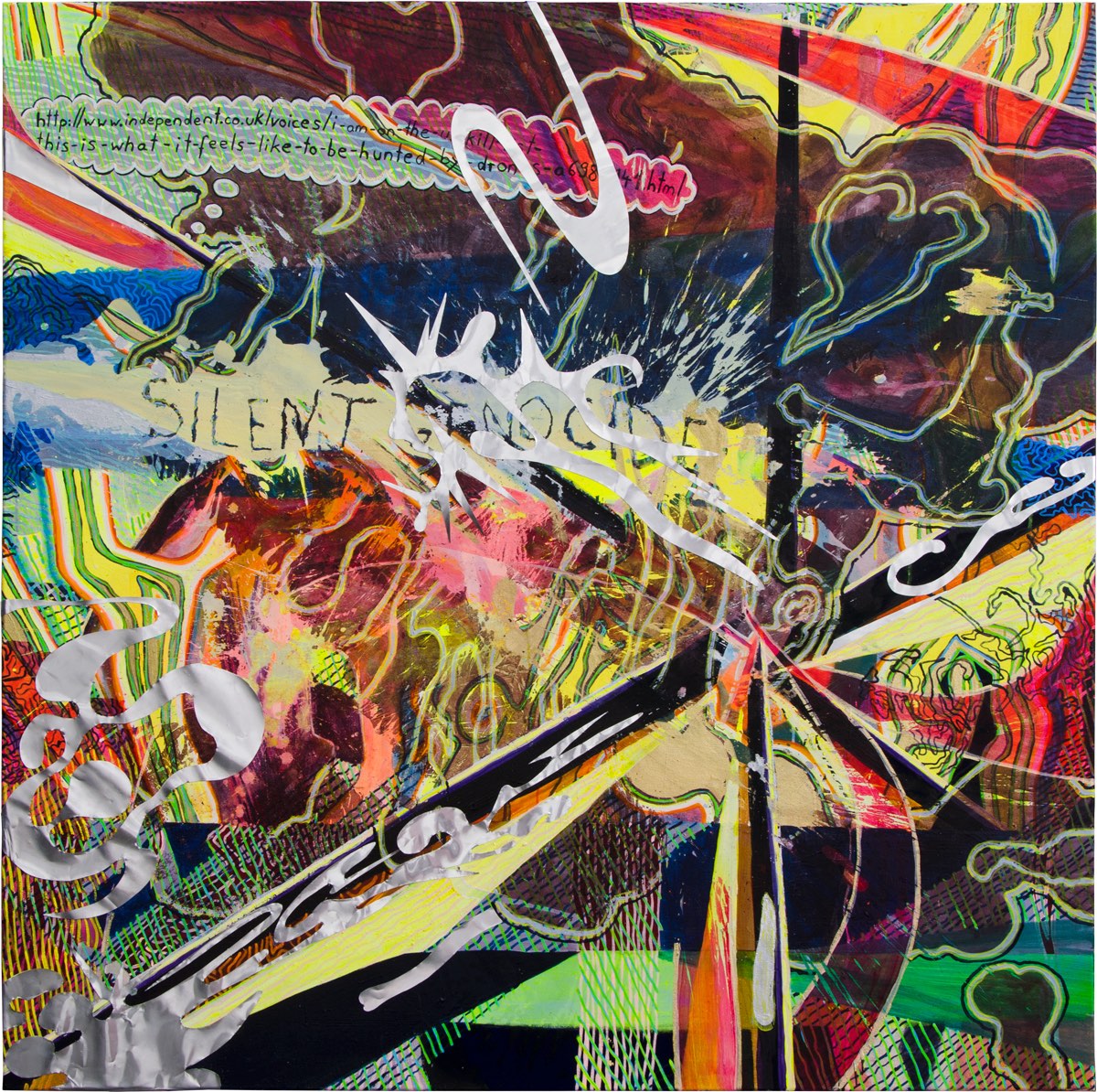
Hadzici (2016), Aluminum, Egg Tempera & Oil on Canvas, 150 x 150 cm. (on loan from the artist)
Claudia Chaseling (b. 1973 in Munich, Germany. Lives and works in Berlin, Germany and Kangaroo Island, Australia)
Dr. Claudia Chaseling received a Masters degree in Visual Art, from the University of the Arts in Berlin (UdK), and in 2019 Chaseling completed her studio-based PhD in visual arts, with a focus on spatial painting, at the Australian National University (ANU) in Canberra. Her work has been exhibited in over sixty solo and group exhibitions, notably in the United States, Australia and Europe. She has been featured in the X-Border Biennial, Finland; the Lueleå Biennial, Sweden; and the Lorne Biennial, Australia. Recent projects include solo exhibitions at Art Gallery Nadezda Petrovic, Cacak, Serbia; Wollongong Art Gallery, Australia; Staatliche Kunsthalle Baden-Baden, Germany; Krohne Art Collection, Eifel, Germany; Yuill Crowley Gallery, Sydney, Australia; Kunstverein Duisburg, Germany; Art-in-Buildings, New York City and Milwaukee, US; among others. Chaseling has taken part in international artist residency programs, including: Art Omi and the International Studio and Curatorial Program in New York, USA; Texas A&M University, USA; and the Australian National University, Canberra, Australia. The Verlag für zeitgenoessische Kunst und Theorie Berlin published her first extensive monograph in 2016. Her work is included in the major survey exhibition and publication “DISSONANCE. Platform Germany” (2022) edited by Mark Gisbourne & Christoph Tannert.
Nezaket Ekici
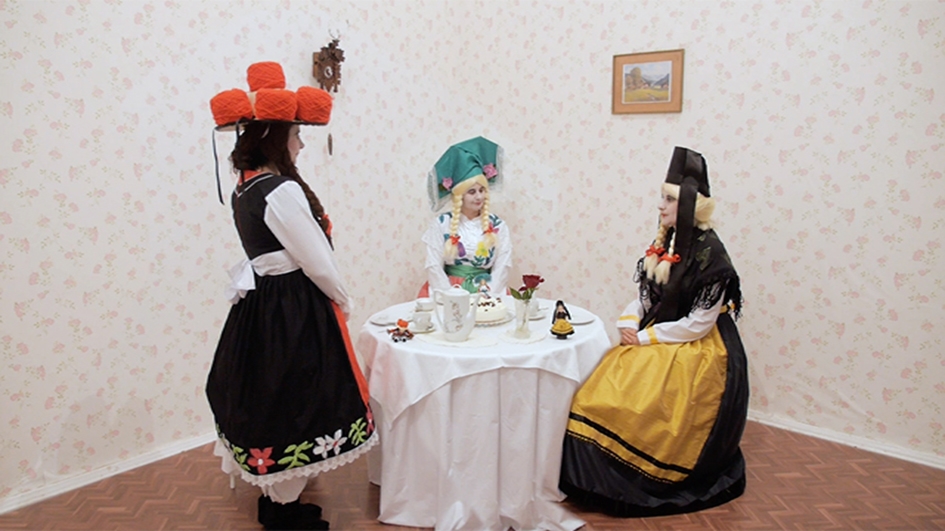
Kaffeeklatsch (2019), HD Video Performance with Sound, 6 min. 17 sec. (on loan from the artist)
In her video performance Kaffeeklatsch, Nezaket Ekici refers to the German afternoon ritual of ‘coffee and cake’, a time of meeting and togetherness for many German families. The history of coffee gossip is a long one. In Germany in the 16th and 17th centuries, with the rise of the bourgeoisie, women began meeting for coffee gossip – “Kränzchen” – to exchange ideas among themselves, allowing them a taste of freedoms that up until then had been reserved for men in social circles. Nezaket Ekici addresses the tradition of the coffee klatsch from her perspective as a migrant and a fully integrated German, questioning her sense of belonging in German society. She asks herself what her own German tradition is – which leads to the general question of what actually is German tradition? In order to answer these questions, Ekici stages herself as three characters dressed in traditional German costumes from the Black Forest, the Spreewald, and Thuringia, representing the south, the north and the center of Germany. With the focus on the articulation, gestures, and facial expressions of the performer, Ekici drinks coffee with her doppelgangers in this playful video addressing the fine line between foreignness and belonging. Watching this work now – on the cusp of the third year of social distancing and intermittent lockdowns, when we have all spent far too much time in our own company – we come to see how very precious this simple freedom is, to gather together with one another.
Nezaket Ekici (b. 1970 in Kirsehir, Turkey. Lives and works in Berlin & Stuttgart, Germany and Istanbul, Turkey.)
Nezaket Ekici holds a degree in Fine Arts, an MA in Art Pedagogy, and an MFA degree, having studied Art History and Sculpture at the Ludwig-Maximilians-University and Fine Arts Academy Munich (1994-2000). From 2001 to 2004 she studied Performance Art under Marina Abramović at the Hochschule der Bildenden Künste Braunschweig. Ekici’s video, installations and performances are often process-based and ask viewers to derive their own emotional and intellectual interpretations. In her work, complex, often controversial topics are tackled with humor in highly aesthetic compostions. Ekici frequently uses her own Turkish origins and education as a subject of tension, pitting her background against her living environment in Germany. Cultural, geographic and individual boundaries, transgressions, gender, authorial bodies, art history, religion, culture and politics are central to Ekici’s works. By highlighting these themes in everyday life and placing them in a new context, she aims to interconnect every element to form a total work of art — a Gesamtkunstwerk. Nezaket Ekici has presented more than 250 different performances in more than 170 cities in over 60 countries on 4 continents.
Selected international exhibitions since 2000 include: Museum Haus der Kunst in Munich; The Irish Museum of Modern art in Dublin; 25. May Museum Belgrade; PAC Milano; Venice Biennale; P.S.1 New York; Van Gogh Museum Amsterdam; Reina Sophia Museum, Madrid; Museum of Contemporary Art, Istanbul; The Museum of Contemporary Art Taipei/ Taiwan; Poznan Biennale; Curiciba Biennale; Tel Aviv Museum of Art; Istanbul Modern; Marta Herford; Minsheng Art Museum Shanghai; Haus am Waldsee Berlin; KunstWerke Berlin; Oslo Museum; The Contemporary Art Gallery of Georgia, Georgia National Museum, Tbilisi; Museum of Contemporary Art in Krakow, Total Museum Seoul, and many more. Ekici was an Artist-in-Residence at the Cultural Academy Tarabya, Istanbul (2013-14), was the recipient of the Rome Prize for an Artist Residency at the German Academy, Villa Massimo, Rome (in 2016-17); and participated in the Schlingensief Opera Village Residency in Burkina Faso, Africa (2021). She received the Paula Modersohn-Becker Art Award (2018), and received the Berlin Culur Senate prize for her Artist Residency at the International Studio & Curatorial Program (ISCP) in Brooklyn, New York (2020).
David Krippendorff
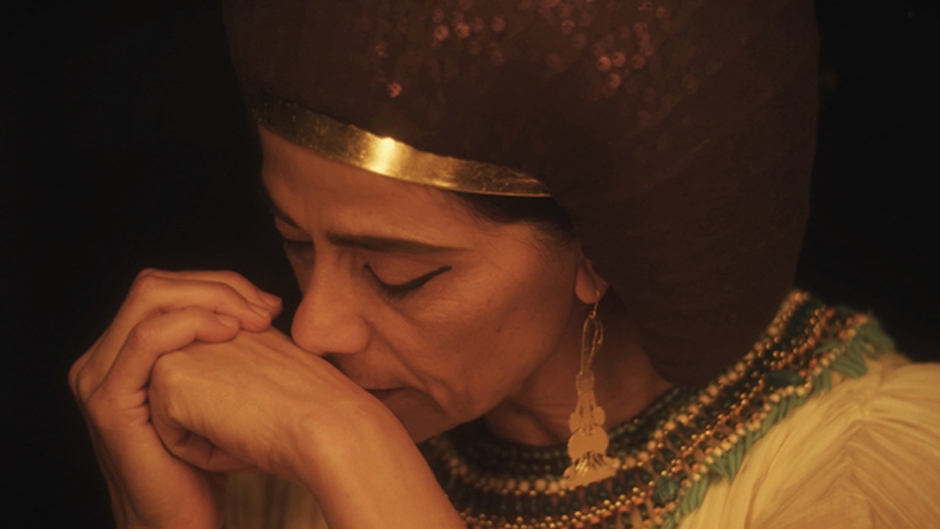
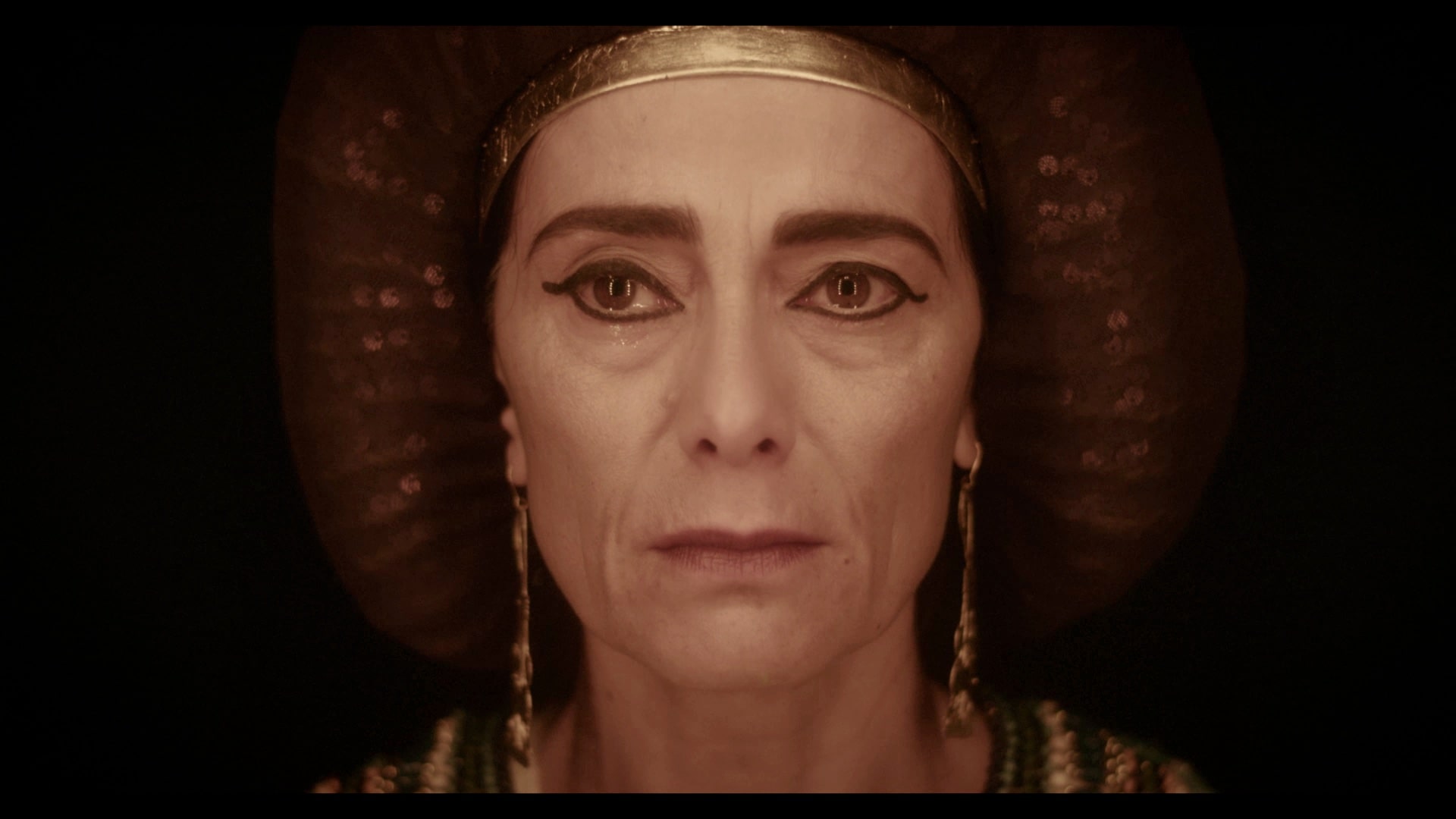
David Krippendorff, Nothing Escapes My Eyes (2015), HD Video with Sound, 14 min. 9 sec. (courtesy of MOMENTUM Collection)
Nothing Escapes My Eyes takes us on an intimate journey through identity and history. David Krippendorff’s time-warping tribute to a changing world presents a would-be Aida, to a moving soundtrack from the eponymous opera, shedding tears for a place and time which no longer exist.
“Nothing Escapes My Eyes is about a silent transformation of a place and a human being, both subjected to the melancholy of conforming. The film was inspired by the famous opera Aida, to depict in a metaphoric form current issues of cultural identity, loss and the pressures to conform. The film refers to the following historical event related to this opera: Aida premiered in Cairo in 1871 at the Khedivial Opera House. One hundred years later the building was completely destroyed by fire and replaced by a multi-story parking garage. Nevertheless, to this day, the place is still named Opera Square: Meidan El Opera. The film combines this urban alteration with the painful transformation of a woman (actress Hiam Abbass) in the process of shedding one identity for another. With no dialogue, the film is backed by a musical excerpt from Verdi’s opera Aida, whose lyrics express the difficulties of being loyal to one’s country and cultural identity. The personal and urban transformation tackles issues of identity, loss and disorientation as a result of historical colonialism and contemporary globalization.”
[David Krippendorff]
David Krippendoff (b. 1967 in Berlin, Germany. Lives and works in Berlin)
David Krippendorff is a US/German interdisciplinary artist and experimental filmmaker. He grew up in Rome, Italy, and studied art at the University of Fine Arts in Berlin, where he graduated with a Masters degree in 1997, and was subsequently based in New York for some time. The son of a Holocaust survivor and the grandchild of practicing Nazis, cultural contradiction and dislocation shaped Krippendorff’s experience early on. His artistic practice inquires into this state of being a “permanent foreigner” and explores resulting questions of home, national and cultural identity, and belonging. Krippendorff’s works, films and videos have been shown internationally, including at: the New Museum (New York), ICA (London), Hamburger Kunsthalle (Hamburg), Museum on the Seam (Jerusalem). He has participated in four Biennials (Prague, Poznan, Tel Aviv, and Belgrade), as well as in many international art and film festivals worldwide.
Milovan Destil Markovic
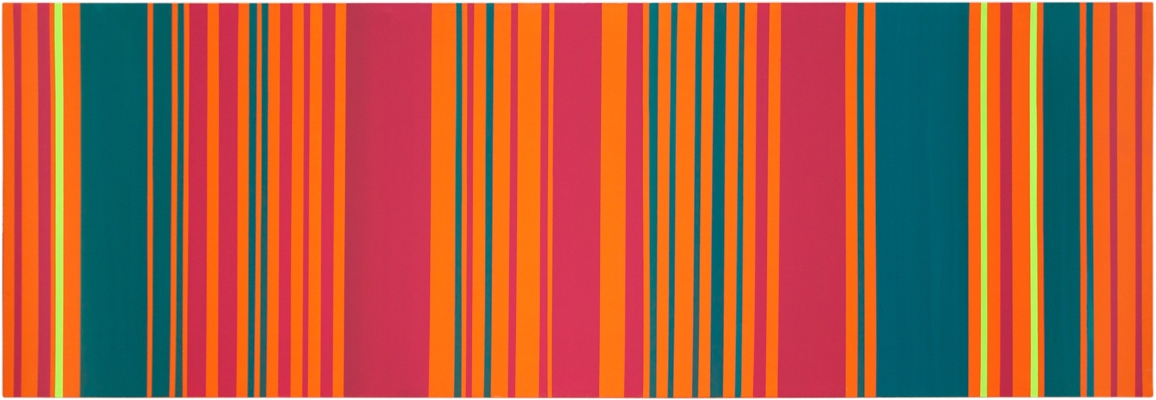
It Really Did Fill My Mouth (Morning) (2013), Pigments on Canvas, 186 x 250 cm (on loan from the artist)
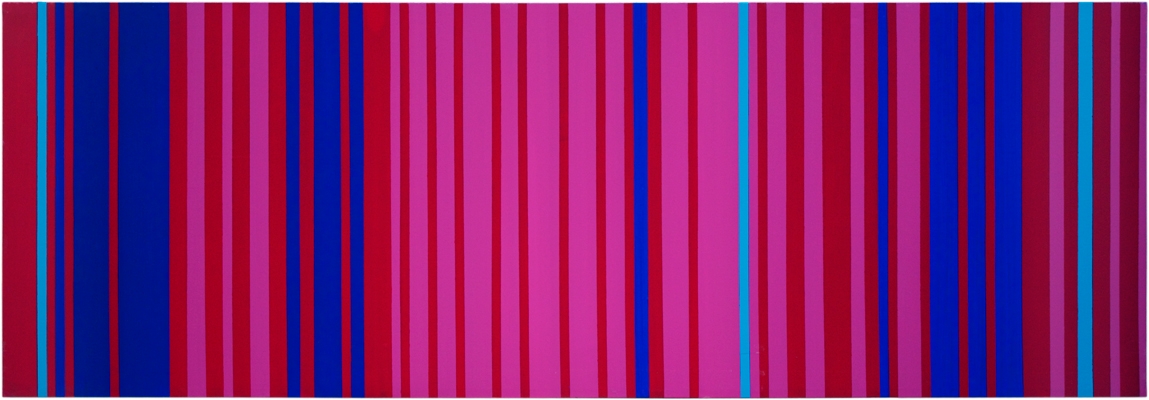
Missionary Position (2009), Pigments on Canvas, 186 x 250 cm (on loan from the artist)
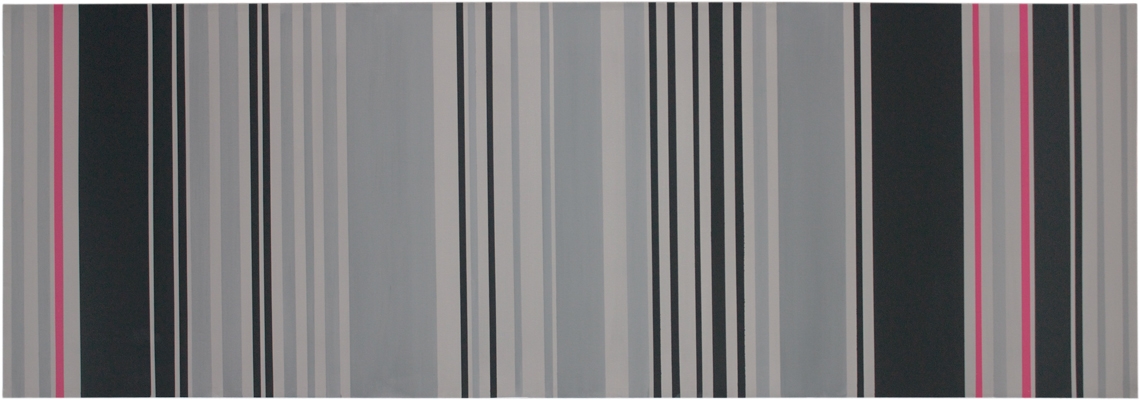
It Really Did Fill My Mouth (Evening) (2013), Pigments on Canvas, 186 x 250 cm (on loan from the artist)
Milovan Destil Marković’s series of Transfigurative Paintings are the result of intensive research and the attempt to develop and expand the idea of the portrait. In his ongoing series of Barcode Paintings, Marković uses barcodes to signify written words through colourful, bright stripes on his canvases. Every text can be translated into a barcode that is the product of a systematic process of codification, at the end of which only a rhythmic series of vertical lines remains. This abstraction allows for an international rationalized system of merchandise management, the organisation and distribution of commodities. In Marković’s work, there is a tension between the image as an abstract painting and the barcode as algorithmic script. The content of each image is revealed through the title of the painting.
The titles of the three bar code paintings shown here are quotations from the infamous memoir “The Sexual Life of Catherine M.”, the autobiography of Catherine Millet (renowned French writer, art critic, curator, and founder and editor of the magazine Art Press).
Marković’s works contain short text quotations from pornographic literature, politics and banking; representations of the world of power and oppression. His barcode paintings veil their content behind a normalised form; at once the language of commerce, and a kind of digital calligraphy. They can be understood either as an impish joke on the part of the artist, or as a critique of the opaque structures of markets that mask their global deficiencies and injustices. As a sly comment on the possibility of art as commodity, printed on the side of each painting is a barcode: the normal-sized, black and white version of the content of each barcode painting.
Milovan Destil Marković (b. in 1957 in Čačak, Serbia. Lives and works in Berlin, Germany.)
Milovan Destil Marković is a visual artist who studied painting at the Faculty of Fine Arts at the University of Arts, Belgrade, where he graduated in 1983. Defining himself as a conceptual painter, Marković has exhibited extensively in Europe, Asia, Australia and in the Americas. His work was featured at 42nd Venice Biennial (Aperto ’86), 4th Istanbul Biennial, 46th Venice Biennial, 6th Triennial India New Delhi, 56th 49th 24th October Salon Belgrade Biennale, 2018 Lorne Sculpture Biennale, Hamburger Bahnhof Museum für Gegenwart Berlin, Museum of Contemporary Art Kumamoto, MoMA PS1 New York, Moderna Museet Stockholm, Ludwig Museum Budapest, Saarland Museum Saarbrücken, The Artist’s Museum Lodz, National Museum Prague, Museum of Contemporary Art Belgrade, MSURS Museum of Contemporary Art Banja Luka, Landesmuseum Graz, Kunstmuseum Düsseldorf, Museum of Modern Art Ljubljana, National Gallery Athens, Art Museum Foundation Military Museum Istanbul, KW Institute for Contemporary Art Berlin, Kunstverein Hamburg, Kunstvoreningen Bergen, Kunstverein Jena, Galleri F15 Oslo, Nishido Contemporary Art Tokyo, Fei Contemporary Art Center Shanghai, Museum of Modern Art Ljubljana and many others. Marković’s works are held by numerous public and private collections throughout the world, including: Contemporary Art Museum, Kumamoto, Japan; Neuer Berliner Kunstverein, Berlin, Germany; Museum of the City of Belgrade, Serbia; Istanbul Art Museum Foundation, Istanbul, Turkey; Museum of Contemporary Art, Belgrade, Serbia; Kunstmuseum Düsseldorf, Düsseldorf, Germany; Landesmuseum Joanneum, Graz, Austria; The Artists’ Museum, Lodz, Poland; amongst others.
David Szauder
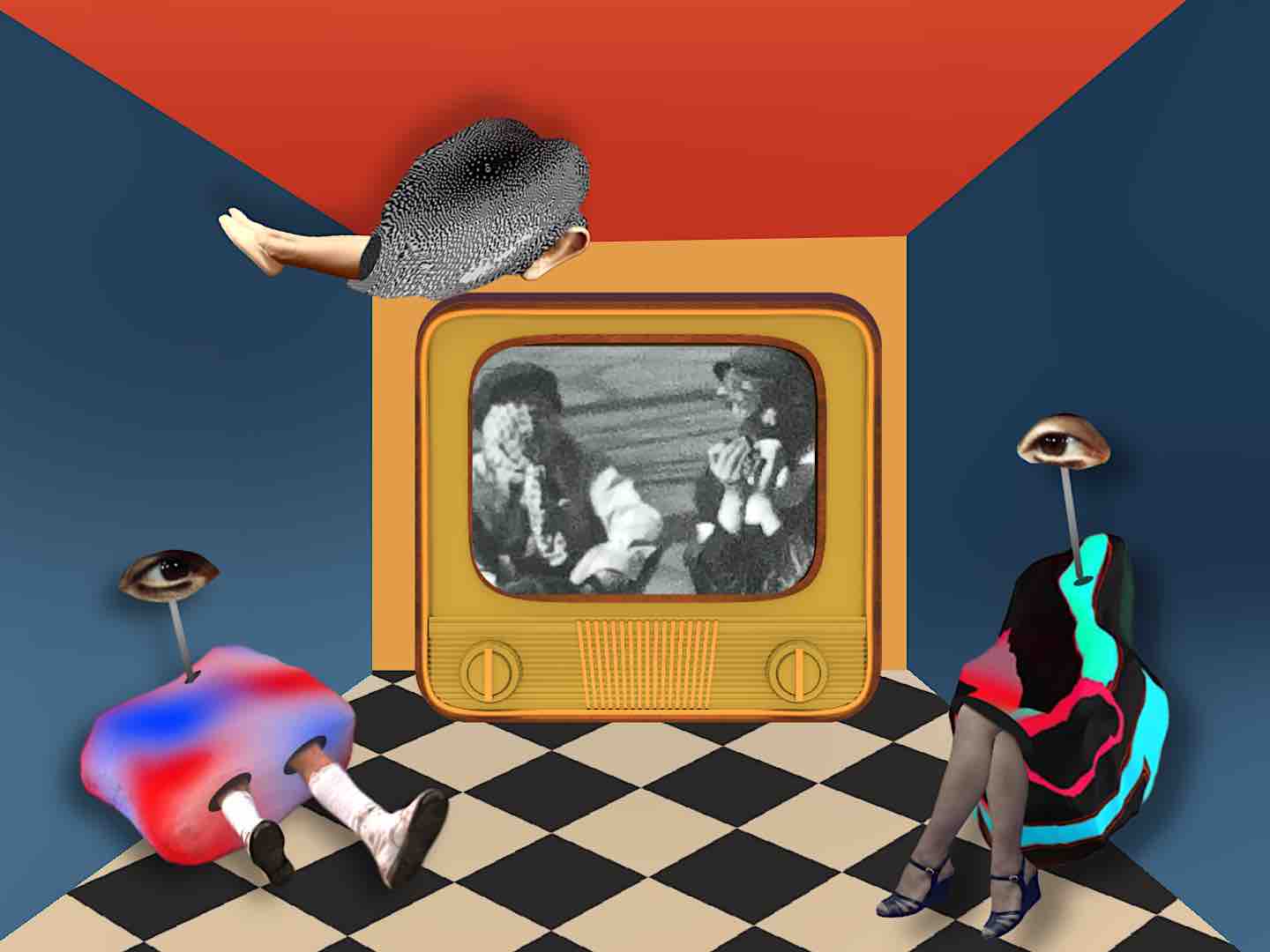
David Szauder, Parallel Universes (2021), 4 Digital Animation Loops, with Original Sound
I. The Dream of the Statue (Budapest) 1971-2021, 1’20”
II. Changing of the Guard (Berlin, DDR) 1972-2021, 1’14”
III. Busó (Mohács, Hungary) 1967-2021, 1’09”
IV. Parallel Dimension (Budapest, Prague, Balaton) 1967-2021, 1’10”
In this series of work, Hungarian media artist David Szauder re-animates original Super 8 footage shot by his grandfather in the 1960-80’s. Superimposing his own somewhat surrealistic universe onto the historic footage, Szauder conveys the sense of a world perpetually going slightly mad. And perhaps it is. In the state of our world today, where nationalism, political tensions, and the closing of borders are on the rise, it would indeed be mad not to look back upon the lessons of history. The artist’s grandfather developed his passion as an amateur filmmaker with the purchase of his first 8mm camera in the 1960s. Through its lens, he recorded glimpses of the world he was allowed to see, travelling as much as he was permitted within the political constraints and physical borders of the Eastern Bloc. Upon his grandfather’s death, David Szauder inherited a time-machine – a collection of over 1000 rolls of film archiving the world as his grandfather saw it. This footage forms the basis for much of Szauder’s recent work, exploring memory in the light of personal and collective history.
The Dream of the Statue (Budapest) 1971-2021
For the past seven decades, the most distinctive feature of the Budapest skyline standing tall above Gellért Hill is the Liberation Monument, a Soviet-built metal statue looking eastward as a tribute to the Red Army’s triumph over Hungary’s Nazi occupiers during World War II. Because of this politically fraught past, several movements attempted to remove this feminine figure over the years, but it has persevered to become an iconic symbol of Hungary’s capital.
Changing of the Guard (Berlin, DDR) 1972-2021
These guards protected the eternal flame in Berlin’s Neue Wache, the Memorial for the Victims of War and Tyranny on Unter den Linden, between 1969 and 1989. Yet in Szauder’s universe, they’ve changed their position and are now protecting the Tesla Model S. The world has found its new eternal flame, updated for our aspirational economy of luxury in a form impossible to imagine at the time the original footage was shot.
Busó (Mohács, Hungary) 1967-2021
The Hungarian folk tradition of the Busó festival, shot in the 1960’s by the artist’s grandfather, remains largely unchanged to this day. Marking the end of the annual Carnival season, this procession of terrifying costumed monsters was immensely popular during the Communist regime, supported by the government as a safe non-political form of entertainment. Yet the enduring popularity of Busó today is derived from its appropriation by an opposing force. With a government leaning further and further to the right, the folklore and cultural traditions of Hungary are being today deployed to celebrate nationalist ideals and values.
Parallel Dimension (Budapest, Prague, Balaton) 1967-2021
The 1st of May was celebrated as a holiday for workers in every socialist country, with parades of labourers from factories and communes, pioneers and party members. Szauder comingles footage from various May Day celebrations in Hungary and what was then Czechoslovakia with his whimsical animations in a game between visible and invisible – much like the political subtexts of these enforced displays of ideology.
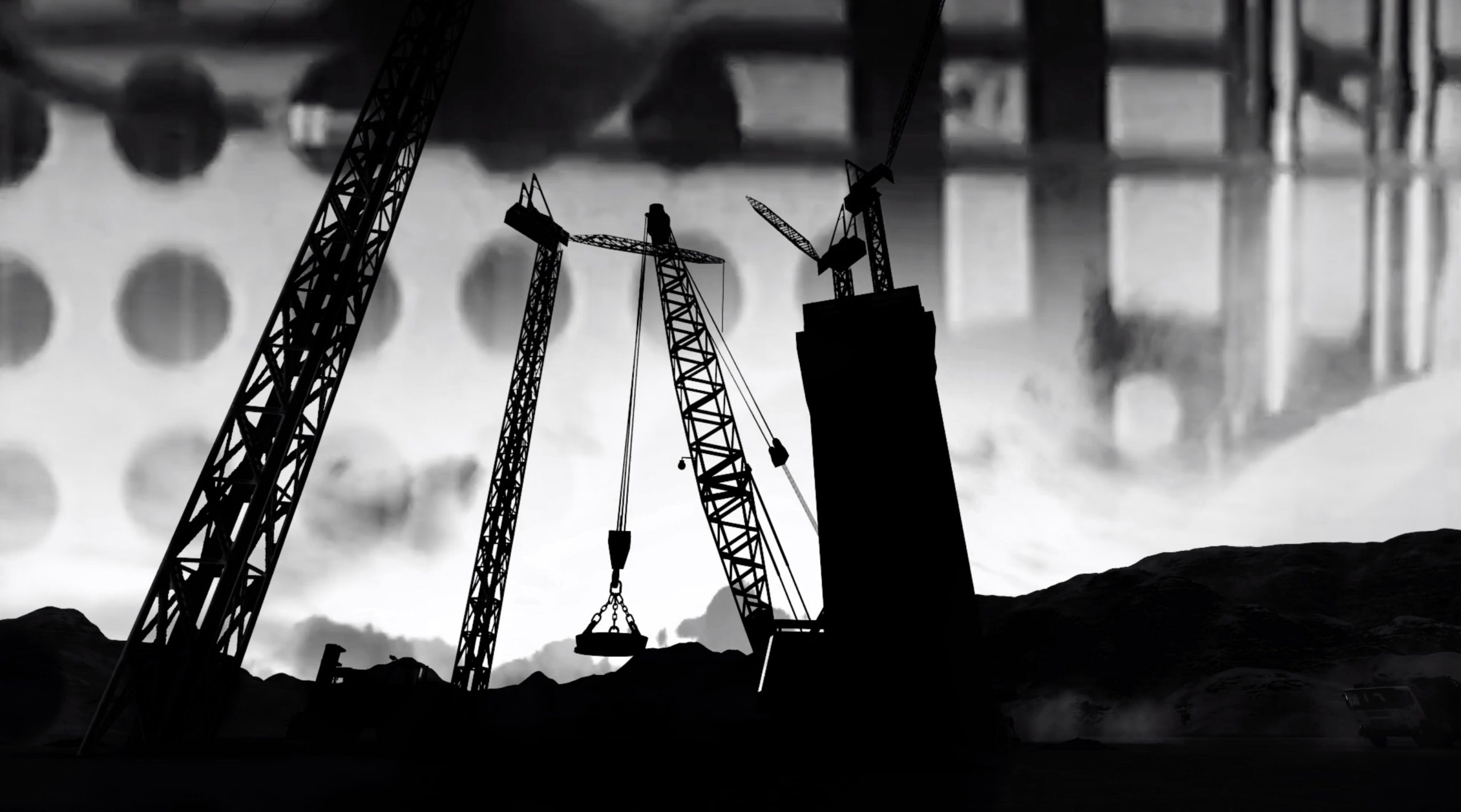
Light Space Materia (2020), HD Video & Digital Animation with Original Sound, 8 min. 27 sec. (courtesy of MOMENTUM Collection)
David Szauder’s film Light Space Materia (2020) translates Bauhaus ideas on technology, new materials, and light into a digital context, upgrading an iconic work of the 1930’s into a 3D digital animation and algorithmically derived soundscape. Taking as his inspiration the kinetic light and sound sculpture Light Space Modulator (1930) by one of the founding fathers of the Bauhaus, Moholy-Nagy, David Szauder re-created his own large-scale rendition of this iconic work – Light Space Modulator (2020). Szauder subsequently used this installation as the basis upon which to make a series of over 100 videos, digital animations, and soundscapes. David Szauder recontextualizes into digital media the driving principal of the Bauhaus, Moholy-Nagy’s aim to revolutionize human perception and thereby enable society to better apprehend the modern technological world. Szauder’s analysis of the Bauhaus-related kinetics of the original piece focuses on the fundamental question of how contemporary technology could change the formal expression of movement and capture the physicality of materials in a digital context. The Bauhaus always held an important pioneering position in the relationship of art to technology. For this reason, this characteristic always formed an essential basic notion of Szauder’s work, and led him to use computer code when creating his animations. The code contributed to a better understanding of the compositional methods and movements and opened a new door for the perception of the 3-dimensional kinetic world. As the last step, a soundscape was derived from the ambient sound and kinetic movement of Szauder’s Light Space Modulator sculpture using algorithms based on motion analysis. This soundscape accompanies Szauder’s film Light Space Materia, which commingles found footage related to the seminal ideas of the Bauhaus with digital 3D animations made by the artist to foreground the haptic qualities of the materiality of the image.
David Szauder (b. 1976 in Hungary. Lives and works in Berlin, Germany.)
Media artist and curator David Szauder (b. 1976 in Hungary) studied Art History at the Eötvös Loránd University and Intermedia at the Hungarian University of Fine Arts in Budapest, and completed a Masters Fellowship at the School of Arts, Design and Architecture at the Aalto University in Helsinki. From 2009 to 2014 he worked as the curator at the Hungarian Cultural Institute in Berlin (.CHB). David Szauder is a visiting lecturer at the Film Academy, Potsdam, in addition to leading workshops on interactive media in Berlin and Budapest since 2010. He is the Founder and Artistic Director of Buildingscape, an initiative to turn construction sites into venues for public art. Since 2019, he is the New Media Advisor for the Artistic Director of the VEB 2023 European Capital of Culture.
David Szauder has participated in numerous international projects as artist and curator. Projects in cooperation with MOMENTUM include: “MOMENTUM InsideOut: Lockdown Schmockdown” at CHB Collegium Hungaricum (Berlin, 2021); “Light Space Modulator” at MOMENTUM (Berlin, 2020); “Art Nomads: Made in the Emirates” at Studio 1, Kunstquartier Bethanien (Berlin, 2016);“Ganz Grosses Kino” KIK Eight at Kino International (Berlin, 2016); MOMENTUM InsideOut: Amir Fattal, “Atara” (Berlin Gallery Weekend, 2015); MOMENTUM InsideOut: “A Time for Dreams” & “Budapest Sketch”(Berlin Art Week, 2014); “PANDAMONIUM Preview // INTERPIXEL: Media Art from Shanghai and Budapest” (Berlin Gallery Weekend, 2014); “INTERSECTION”: Film and Video Art Panel Discussion for Berlinale (Berlin Film Festival, 2014); “THRESHOLDS”: Performance, Exhibition, Discussion (.CHB, Berlin Art Week, 2013); “THRESHOLDS” (TRAFO Center for Contemporary Art, Stettin, Poland, 2013-2014); MOMENTUM InsideOut: “Mass & Mess” (TRAFO Center for Contemporary Art, Stettin, Poland, 2013).
Mariana Vassileva
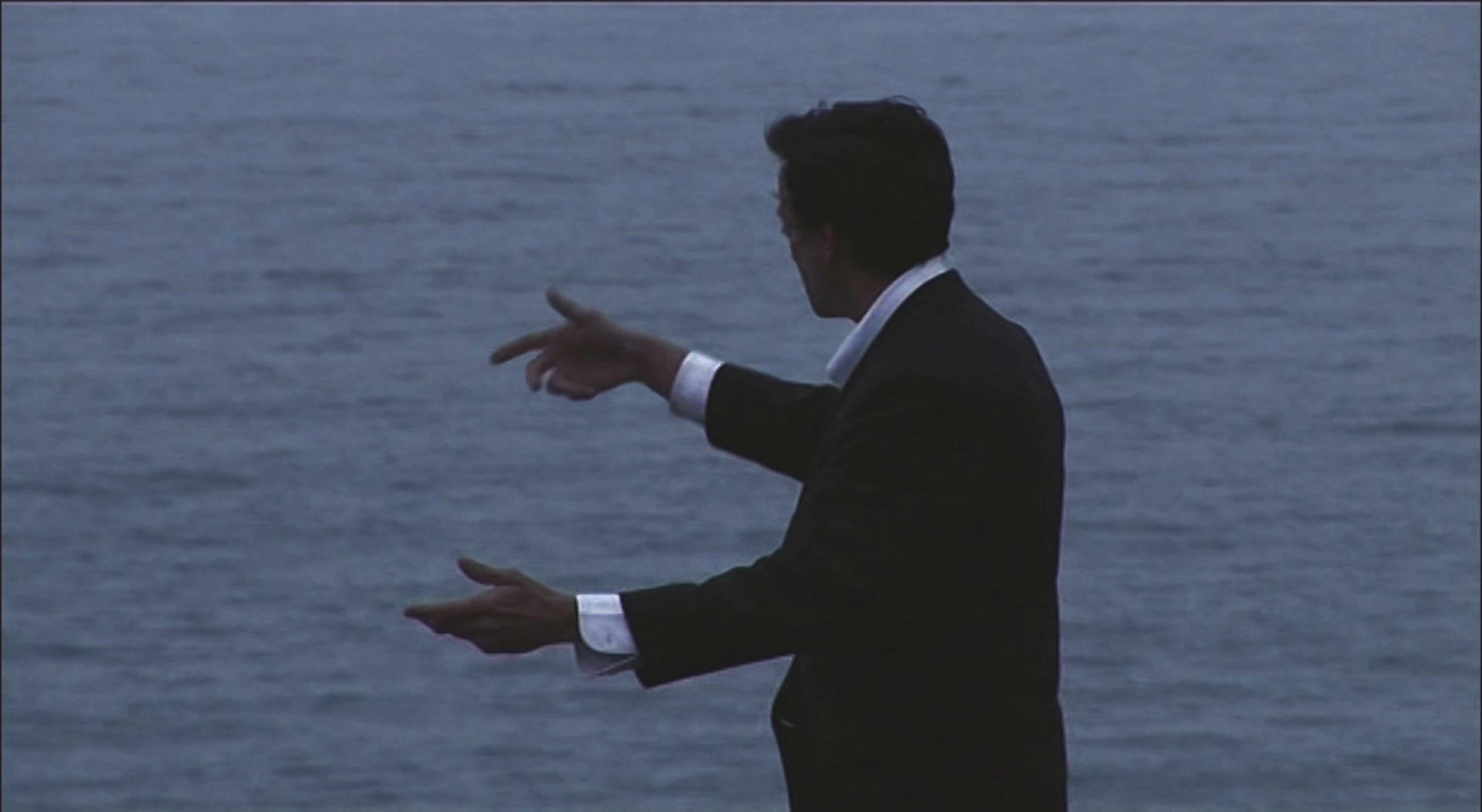
Lighthouse (2009), HD Video with Sound, 4 min. 30 sec. (on loan from the artist)
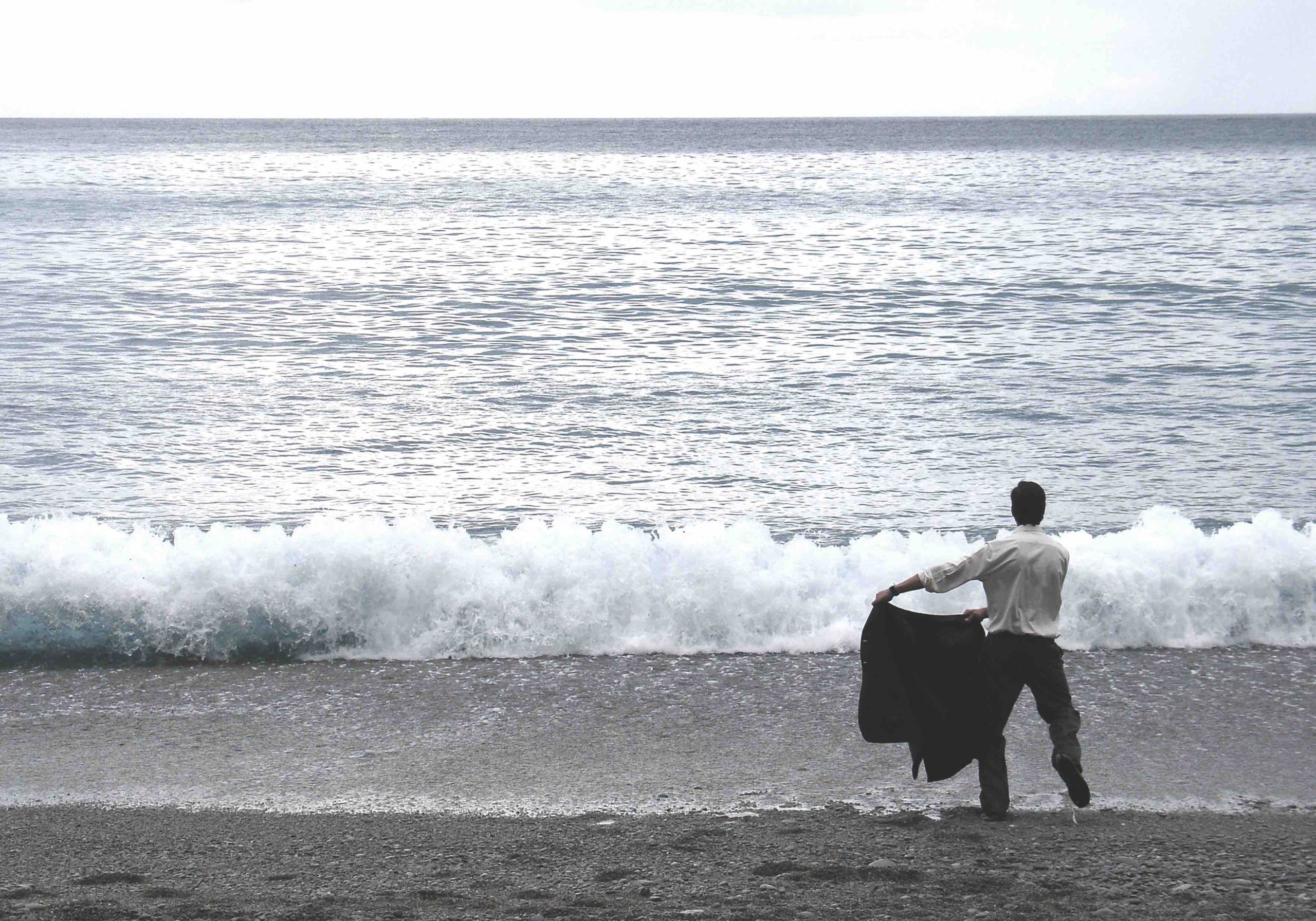
Toro (2008), HD Video with Sound, 5 min. (on loan from the artist)
Marianna Vassileva’s video, Lighthouse, opens with a man driving out to the sea. Confronted by the immensity of the ocean and its implacable rhythms, he conducts nature’s symphony – the winds and the waves. While in Vassileva’s film, Toro, the same man once more confronts the sea. This time, he fights against the waves, challenging them much as a toreador waves his cape at a charging bull. This simple gesture is both as futile and as eloquent as Don Quixote tilting against windmills. Both films together paint a poetic allegory of mankind’s relation nature. Confronted by our helplessness in the face of the elements, we try to control them, to bend them to our will.
Mariana Vassileva (b. 1964 in Bulgaria. Lives and works in Berlin.)
Mariana Vassileva graduated from the Universität der Künste, Berlin, in 2000, and has remained in Berlin since that time. Working across varied mediums such as video, sculpture, installation, and drawing, Vassileva’s practice is concerned with the poetry that lies beneath the quotidian and the routine. Based upon observation of daily life, her works respond to an element of playfulness inherent in artist and viewer alike. With the curious gaze of a voyeur or of an urban anthropologist, the artist observes people and their surroundings in order to capture a moment of poetic imagery. Watching, and the distance it implies, are both method and subject of a body of work reflecting on human concerns familiar to us all: communication, cultural displacement, relations with self and other, loneliness and the humor hidden within the rhythms of the day-to-day.
Mariana Vassileva is an internationally acclaimed interdisciplinary artist, having shown in major institutions including: Musée d’Art Contemporain de Montréal (Canada); Tate Britain (UK); Centre Pompidou (Paris, France); Museo Nacional Centro de Arte Reina Sofía (Spain); Museum of Fine Arts (Boston, USA); The Israel Museum (Jerusalem); Kunstmuseum Wolfsburg (Wolfsburg, Germany); Weserburg Museum für Moderne Kunst (Germany); Kunsthalle zu Kiel (Germany); Edition Block (Berlin, Germany); The Stenersen Museum (Oslo,Norway); Total Museum (Seoul, Korea); Hong Kong Arts Centre (Hong Kong).
Mariana Vassileva has participated in several international Biennials, including: the 1st Biennal del Fin del Mundo, Ushuaia, Tierra del Fuego, (Argentina, 2007); the 17th Biennale of Sydney, The Beauty and the Distance: Songs of Survival in a Precarious Age, (Australia, 2010); the 4th Moscow Biennale of Contemporary Art, Rewriting Worlds, (Russia, 2011); Biennale Vento Sul in Curitiba, (Brasil, 2012); the 56th October Salon, Belgrade Biennale, The Pleasure of Love, (Serbia, 2016).
Vassileva’s works are held in international public collections, including: Kunstmuseum Wolfsburg (Wolfsburg, Germany); Rene Block Collection (Berlin, Germany); Koc Museum (Istanbul, Turkey); The Israel Museum (Jerusalem, Israel); La Caixa, Caja de Ahorros de El Monte y Fundacion el Monte (Spain); Lemaitre Collection (London-Paris); Kunsthalle Emden (Germany); Lidice Memorial.
Vadim Zakharov
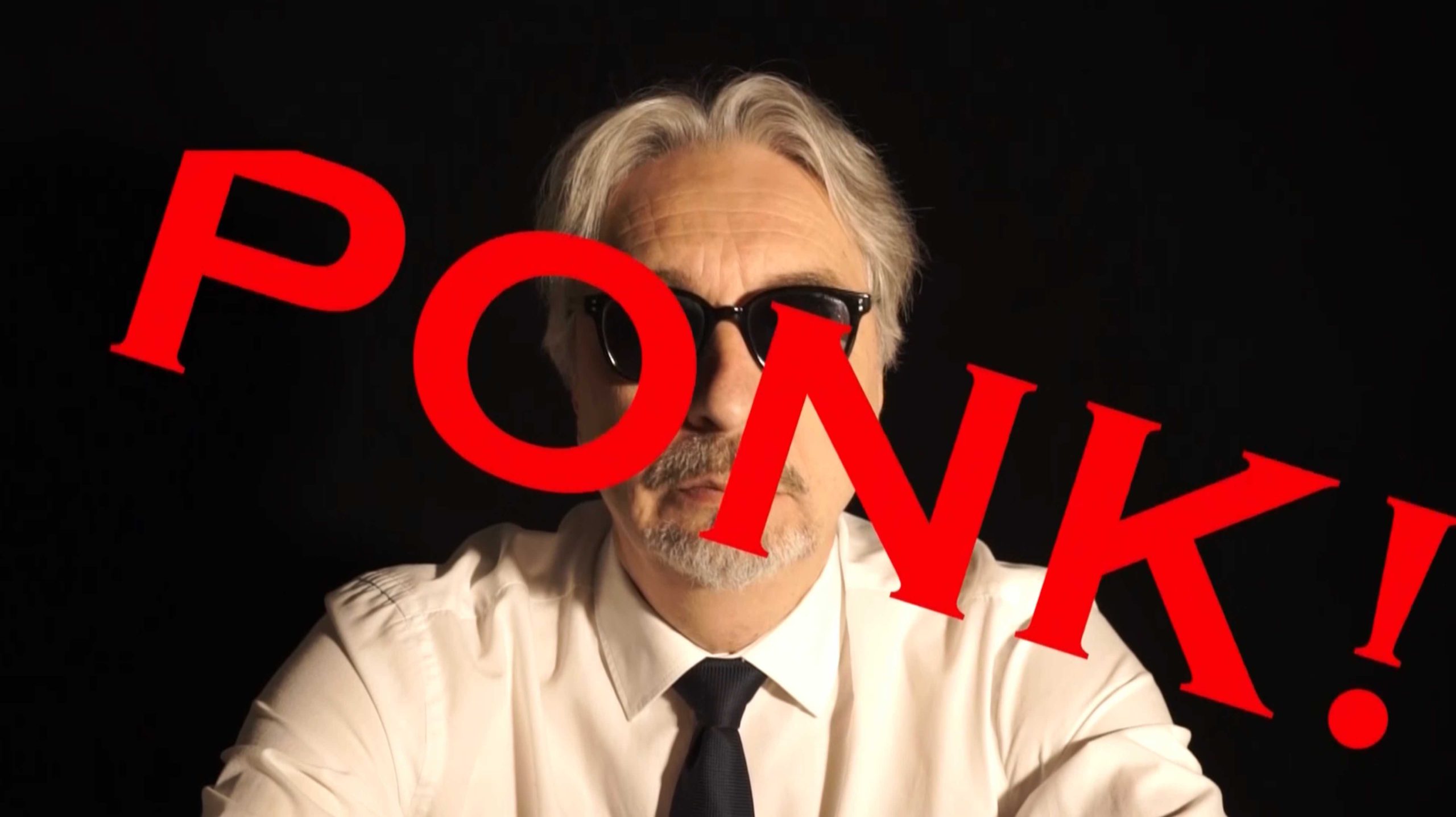
Vadim Zakharov, BAFF BAFF! What Are The Politicians Talking About (2021), HD Video Performance with Sound, 4 min. 20 sec. (courtesy of MOMENTUM Collection)
Vadim Zakharov’s most recent video work presents an all too fitting commentary on our current state of affairs where politicians spout nonsense at one another while remaining unable to stop the atrocities of war. BAFF BAFF! What Are The Politicians Talking About invokes the talking heads we see on news programs every day, recounting an equally incomprehensible reality which would be surreal were it not so tragic.
“In the video performance, non-verbal words are read aloud, most of which have been found in the magazines “Mickey Mouse” (German editions) and also taken from the books “Tintin The Mysterious Star” and “Asterix & Obelix The Laurels of Caesar”. The words collected in the non-verbal vocabulary have no meaning, but only phonetically reflect certain events: someone has fainted (BLIEP!), a glass has broken (CRACK! CLIRR!), a helicopter has crashed into a cupola (KAROMMS!), a museum has collapsed (CRACK! THUNDER! CRIME!).
The Reader (Vadim Zakharov), wearing a white shirt and a tie, recites these words seriously and forcefully. The image of a politician is created, a public figure who professionally and convincingly is ready to say something on any occasion. At the same time, we see that these are just empty words – bubbles that float away as soon as they reach our ears. The film highlights the absurdity of what we see and hear every day on television and the internet.
At the same time, reading non-verbal words can be perceived as reading poetry…”
[Vadim Zakharov]
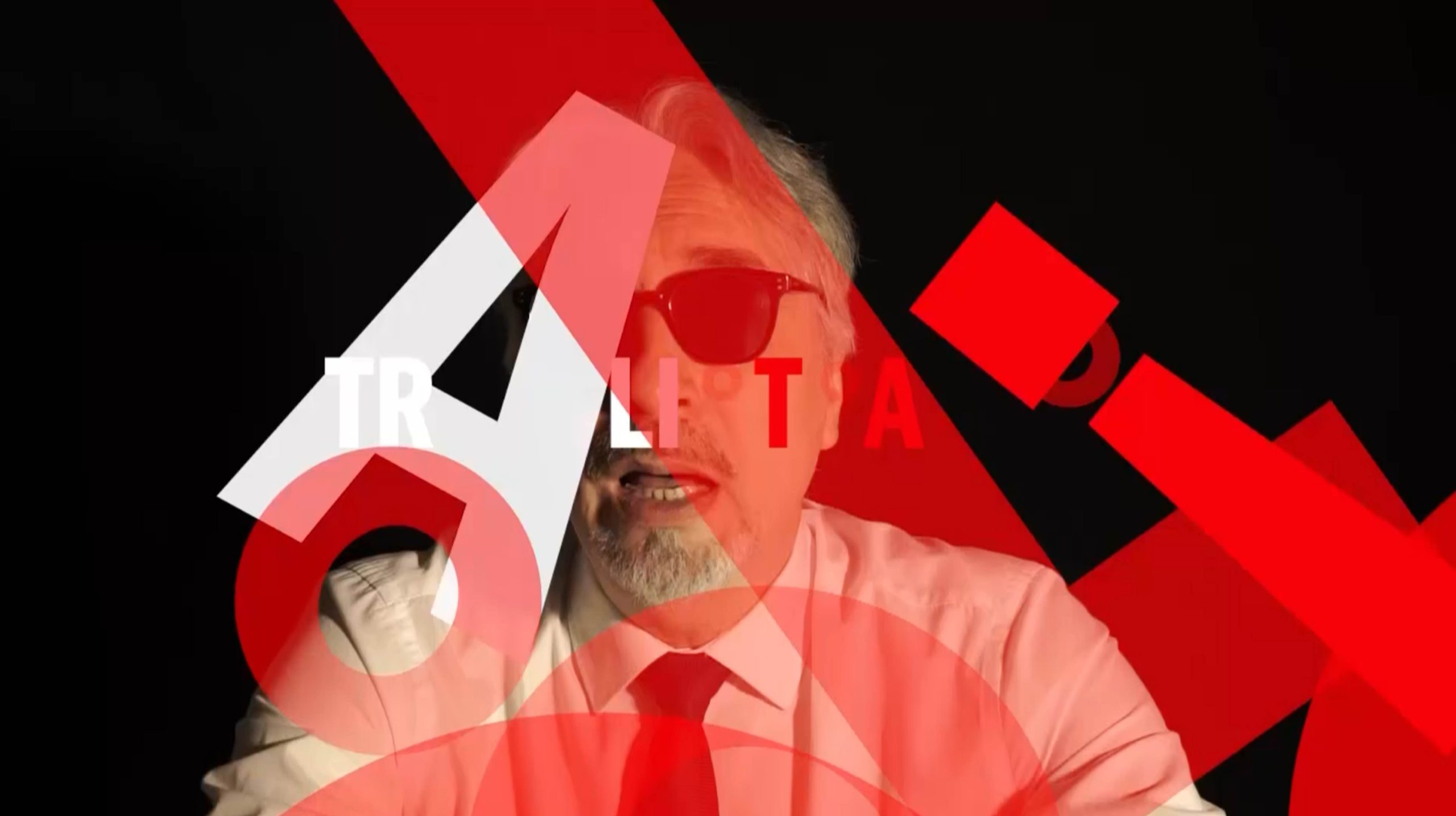
Vadim Zakharov (b. 1959 in Dushanbe, UdSSR (now Tajikistan). Lives and works in Berlin.)
Vadim Zakharov is an artist, editor, archivist of the Moscow Conceptual art scene, and collector. Since 1979 he has participated in exhibitions of unofficial art and collaborated with such artists as: V. Skersis, S. Anufriev, I. Chuikov, A. Monastyrski, Y. Leiderman. In 1982–1983 he participated in the AptArt Gallery, Moscow. Since 1992 till 2001 he has published the “Pastor” magazine and founded the Pastor Zond Edition. In 2006 he edited book “Moscow Conceptualism”. His retrospective was held at the Tretyakov Gallery in 2006. He represented Russia at the Venice Biennale in 2013 with the project “DANAE”. In 2016-2020 Zakharov organized the exhibition space “FREEHOME-Artist to Artist” in Berlin.
Selected honors and awards include: Griffelkunst-Preis, Hamburg (1995); Renta-Preis, Kunsthalle Nürnberg (1995); Soratnik Prize, Moscow (2006); Innovation Prize, Moscow (2006); Joseph Brodsky Memorial Fellowship Fund, American Academy in Rome (2007); Kandinsky Prize – Best Work of Year, Moscow (2009).
In addition to numerous solo and group exhibitions, Vadim Zakharov has participated in many biennales of contemporary art, including: the 49th Venice Biennale, “Plateau of Humankind”, (Director Harald Szeemann, Arsenale, 2001); 1st Thessaloniki Biennale, “Black Birds” installation (Museum of Byzantine Culture, 2007 ); 55th Venice Biennale, Vadim Zakharov, “Danaë”, Russian Pavilion (2013); 5th Moscow Biennale, Vadim Zakharov, “Dead Languages Dance. Fall collection”, (TSUM, 2013); “2014. Space Odyssey”, CAFAM BIENNALE, Beijing (2014); 3rd Biennale of Bahia, Museum of Modern Art of Bahia (2014); 14 Krasnoyarsk Museum Biennale, Russia (2021).
Vadim Zakharov’s works are held in many prestigious public collections, including: Guggenheim Museum, New York, USA; TATE Modern, London, UK; Modern Art Museum, Frankfurt, DE; Deutsche Bank Collection, Frankfurt am Main, DE; Kupferstienkabinet, Berlin, DE; Ludwig Museum, Aachen, Budapest; Saint Petersburg, RU; Zimmerli Art Museum, Rutgers USA; Museum of Art at Duke University, USA; Museum of Fine Arts, Budapest, HU; Strasbourg Museum of Modern and Contemporary Art, DE; Tretyakov Gallery, Moscow, RU; Russian Museum, Saint Petersburg, RU; Museum of Modern Art, Moscow, RU; Moscow Collections of the NCCA, Moscow, RU


 Back to Homepage
Back to Homepage


